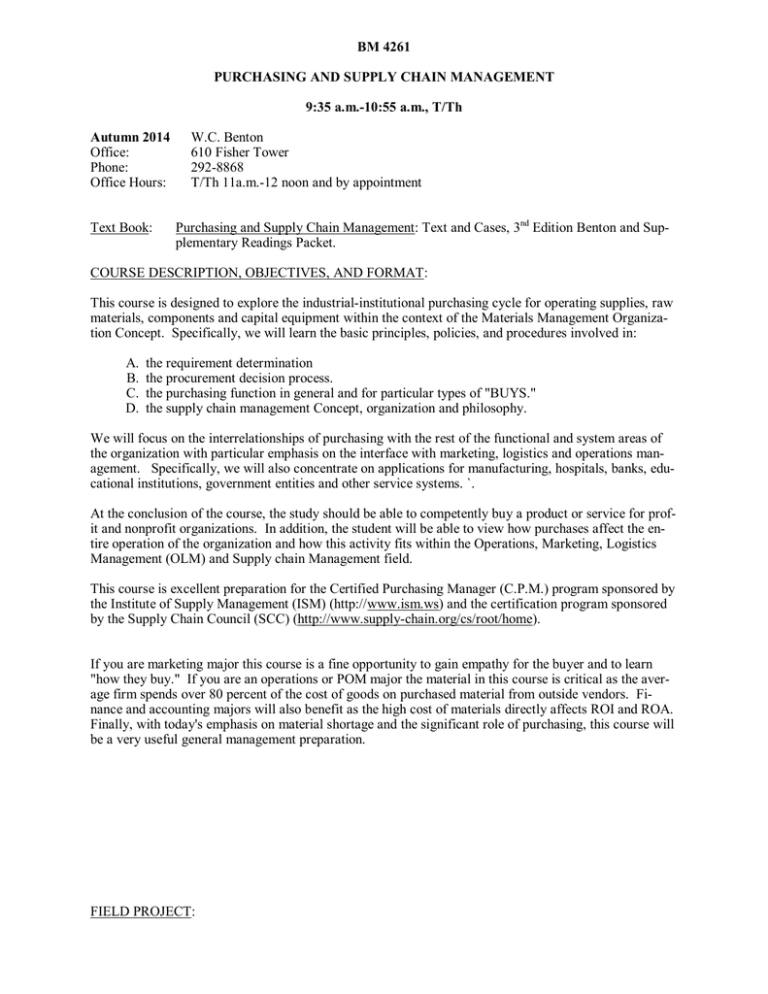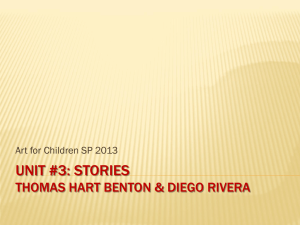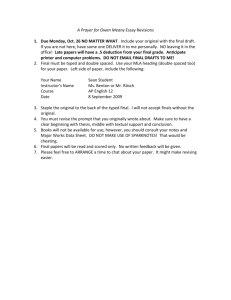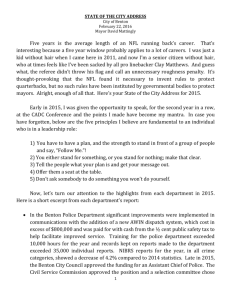BM 4261 PURCHASING AND SUPPLY CHAIN MANAGEMENT 9:35 a.m.-10:55 a.m., T/Th
advertisement

BM 4261 PURCHASING AND SUPPLY CHAIN MANAGEMENT 9:35 a.m.-10:55 a.m., T/Th Autumn 2014 Office: Phone: Office Hours: Text Book: W.C. Benton 610 Fisher Tower 292-8868 T/Th 11a.m.-12 noon and by appointment Purchasing and Supply Chain Management: Text and Cases, 3nd Edition Benton and Supplementary Readings Packet. COURSE DESCRIPTION, OBJECTIVES, AND FORMAT: This course is designed to explore the industrial-institutional purchasing cycle for operating supplies, raw materials, components and capital equipment within the context of the Materials Management Organization Concept. Specifically, we will learn the basic principles, policies, and procedures involved in: A. B. C. D. the requirement determination the procurement decision process. the purchasing function in general and for particular types of "BUYS." the supply chain management Concept, organization and philosophy. We will focus on the interrelationships of purchasing with the rest of the functional and system areas of the organization with particular emphasis on the interface with marketing, logistics and operations management. Specifically, we will also concentrate on applications for manufacturing, hospitals, banks, educational institutions, government entities and other service systems. `. At the conclusion of the course, the study should be able to competently buy a product or service for profit and nonprofit organizations. In addition, the student will be able to view how purchases affect the entire operation of the organization and how this activity fits within the Operations, Marketing, Logistics Management (OLM) and Supply chain Management field. This course is excellent preparation for the Certified Purchasing Manager (C.P.M.) program sponsored by the Institute of Supply Management (ISM) (http://www.ism.ws) and the certification program sponsored by the Supply Chain Council (SCC) (http://www.supply-chain.org/cs/root/home). If you are marketing major this course is a fine opportunity to gain empathy for the buyer and to learn "how they buy." If you are an operations or POM major the material in this course is critical as the average firm spends over 80 percent of the cost of goods on purchased material from outside vendors. Finance and accounting majors will also benefit as the high cost of materials directly affects ROI and ROA. Finally, with today's emphasis on material shortage and the significant role of purchasing, this course will be a very useful general management preparation. FIELD PROJECT: 2 A field project is due at the end of the course and can either be a product buying report or the area specialization report. 1.The Product Buying Report. In this type of report, you are asked to assemble and present all of the information a buyer needs to purchase intelligently a specific product or commodity such as integrated circuits, capital equipment, pumps, or peanut oil. In selecting and presenting the assemble facts, you should indicate what use a buyer might make of these facts. For example, to list only a few, you might report on the following questions: a. The intended use of the product and the requirements to be met by the item purchased. Include all the relevant buying "influences"—which needs to be involved. ``` b. The available products, which might meet these requirements and the characteristics of these products. In discussing the characteristics of these products, the grades, classifications, and properties, which distinguish one product from another, should be defined. One of the available products may be selected for detailed investigation. c. The technical data required in specifying and inspecting the selected product. d. The materials of parts entering into the selected products and an analysis of their sources and availability. e. The methods of manufacture provided that they are significant in selecting suppliers or in appraising quality. f. Supplier selection, i.e., competitive bidding vs. negotiation. g. Factors affecting the supply, demand, price, and inventory of the selected product (an analysis of general business conditions is not intended in this question); however, substitute possibilities and value analysis considerations should be covered. h. Contract terms and type. I. Detailed sources of information on the selected product. 2.The Area Specialization Report. In this report, you are asked to make yourself an "expert" in one specialized area of the purchasing and materials management function. For example, you might choose or be assigned the Make or Buy area. The project would involve learning about this subject from the available literature, perhaps visiting several industrial firms for firsthand discussions, and then report is completed, and you should be able to answer with reasonable ease many penetrating questions in your field of study. In grading this second kind of report, the following guidelines are used: a. Has the writer performed adequate research on this subject? b. Is the research well documented? c. Does the writer fully comprehend this subject? d. How well has the writer explained this subject? e. Are there parts of this subject, which should have been covered and are not covered? f. Is the report free from excessive wordage? ASSIGNMENTS: See the attached Assignment Schedule. 3 EXAMINATIONS AND GRADING: The cases will be graded according to the point criteria in the attached 'case evaluation form (as a guide)." The lowest grade on the homework assignments will be dropped. The field project will be given a letter grade for overall performance. The two midterm exams and a final will be 70 minutes, combination multiple choice and problem-short answer. All examinations will be a combination Multiple Choice Problem-short answer. The final examination will be selectively comprehensive but concentrates on the material after the last mid-term. The final course grading weights are as follows: First Midterm Second Midterm Homework Class Participation Team Project* Final Exam 20% 20% 15% 5% 20% 20% *A team of four to five persons will be assigned to conduct field projects. SUMMARY; As in any endeavor, if you put time into this course, you will take away more than the effort. I hope you find the classes exciting, rewarding and, yes, even fun. You should also consider joining the OSU purchasing and supply management student organization (www.osupsma.com). 4 SESSION TOPIC ASSIGNMENT 1 Introduction to Purchasing and Supply Chain Management · 2 Purchasing Decisions and Business Strategy · · Benton, pages 25-43 3 Materials Management · · Benton, pages 69-84 4 Inventory Management · · Benton, pages 85-99 Benton, Prepare exercises 5.6-5.9 5 Inventory Management 6 Just-in-Time (Lean) Purchasing · · Benton, pages 117-135 7 Purchasing Procedures, EPurchasing, and Systems Contracting · · Benton, pages 139-162 8 Supplier Selection and Evaluation · Benton, pages 167-184 · Benton, pages 185-195 9 Supplier Selection and Evaluation 10 Midterm Benton, pages 3-23 5 11 One Page Term Paper Proposals Due · Ten Minute Team Presentations 12 Make vs. Buy Decisions /Lease vs. Buy · Benton, Appendix 16B, 388-392 13 Strategic Outsourcing 14 Strategic Outsourcing 15 Total Quality Management (TQM) and Purchasing 16 Pricing Determination/Learning Curves 17 Pricing Determination/Learning Curves 18 Second Midterm Examination 19 Markup, Margin and Profitability/Price Cost Analysis · · Benton, pages 197-206 Benton, pages 206-212 Benton pages 261-276 · Benton pages 287-299 · Benton pages 299-303 6 20 Bargaining and Negotiations 21 Bargaining and Negotiations 22 Purchasing, Supply, partnerships, and Supply Chain Power Value Analysis/Review / · Benton, pages 327-338 · · Benton, 338-344 · Benton, pages 237-251 · 7 23 24 Global Sourcing · Benton, pages 215-233 · Benton, pages 349-368 · Benton, pages 369-381 Transportation Purchasing 25 Equipment Acquisition and Disposal 26 No Class Work on Team project 27 Team Presentations 28 Team Presentations 29 Review for final Examination 30 Final Exam *CP=Course Packet: Academic Misconduct: All academic mis0conduct cases will be thoroughly prosecuted according to the most recent rules listed in the student handbook.







